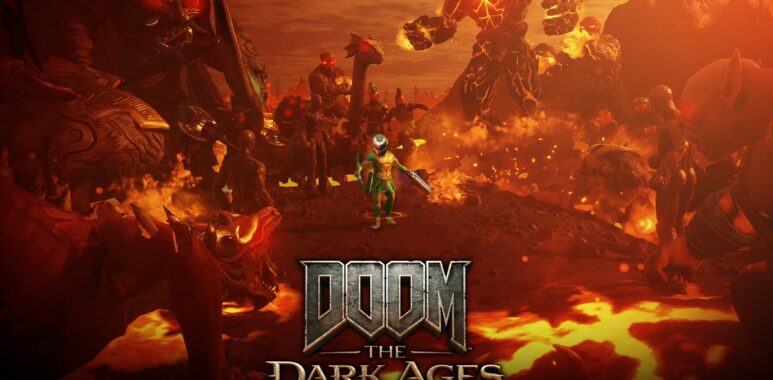
Doom The Dark Ages Review: A Medieval Massacre That Redefines the Slayer’s Saga
Doom: The Dark Ages fundamentally alters the Doom formula, shifting from Eternal’s fighter-jet agility—double jumps, air dashes, and constant motion—to a grounded, tank-like playstyle. The centerpiece is the Shield Saw, a permanent tool that redefines combat. It’s both a defensive bulwark and a brutal weapon, allowing you to block projectiles, parry neon-green attacks for massive damage, and hurl it like a buzzsaw to slice through weaker enemies or stun heavier ones. The shield’s charge ability lets you zip across battlefields, closing gaps with a bone-crunching bash, evoking Captain America with a demonic twist.
The combat loop is slower but no less intense. You’re encouraged to stand your ground, weaving parries, melee attacks (via a new spiked mace or flail), and gunfire into a rhythmic dance of destruction. The arsenal is a highlight: the Super Shotgun remains a devastating classic, while new weapons like the Pulveriser (which grinds skulls into shrapnel) and the Impaler (a pistol that doubles as a sniper rifle) offer versatility. Every gun stays relevant thanks to upgrades, such as the Ravager’s bleed effect for health drops or the Steelshot’s armor-shard ignition. Weapon switching feels deliberate, though some critics note it’s sluggish, punishing experimentation compared to Eternal’s fluidity.
 Levels are vast, often open battlefields filled with dozens of demons, from fodder Imps to beefy Cyberdemons. The game’s 22 missions balance linear kill rooms with non-linear objectives, like shutting down portals or hunting collectibles (gold, codex entries, weapon skins). Exploration is rewarding, with secrets tucked into haunted forests, skull-laden castles, and Lovecraftian Cosmic Realms. However, the open-ended design can feel wearying, and some puzzles—while clever, like bashing glowing symbols or cutting chains—are simplistic.
Levels are vast, often open battlefields filled with dozens of demons, from fodder Imps to beefy Cyberdemons. The game’s 22 missions balance linear kill rooms with non-linear objectives, like shutting down portals or hunting collectibles (gold, codex entries, weapon skins). Exploration is rewarding, with secrets tucked into haunted forests, skull-laden castles, and Lovecraftian Cosmic Realms. However, the open-ended design can feel wearying, and some puzzles—while clever, like bashing glowing symbols or cutting chains—are simplistic.
The game introduces Atlan mechs and dragon-riding sequences, which are visually spectacular but mechanically shallow. Mech battles boil down to dodge-punch combos, while dragon sections involve basic flight and shooting. These “palette cleansers” break up the core action but feel like gimmicks, lacking the depth of on-foot combat. Critics agree they’re brief enough not to overstay their welcome, but they pale next to the shield-driven slaughter.
 Accessibility is a strength, with difficulty modes from forgiving to brutal (Hurt Me Plenty balances challenge well) and sliders for parry windows, game speed, and colorblind settings. The lack of multiplayer doesn’t hurt, as the campaign’s depth—spanning 16-20 hours—offers ample replayability, though some wish for more post-campaign content beyond secret hunting.
Accessibility is a strength, with difficulty modes from forgiving to brutal (Hurt Me Plenty balances challenge well) and sliders for parry windows, game speed, and colorblind settings. The lack of multiplayer doesn’t hurt, as the campaign’s depth—spanning 16-20 hours—offers ample replayability, though some wish for more post-campaign content beyond secret hunting.
Powered by the new id Tech 8 engine, Doom: The Dark Ages is a visual marvel. Its medieval sci-fi fantasy world—think Viking warriors with high-tech comms battling techno-demons—bursts with detail. Levels span blasted heaths, gothic cathedrals, and mind-bending Cosmic Realms with cyclopean architecture, all rendered with ray-traced reflections and dynamic lighting. Weather effects, like rain-soaked mud or glowing fireballs, enhance immersion. The game runs smoothly, with minor hitches when large enemies spawn, and supports DLSS Frame Generation for high-end PCs.
The soundtrack, while not reaching Mick Gordon’s iconic heights, is a pulse-pounding heavy metal banger. It complements the chaos without overpowering it, with standout tracks during boss fights. Sound design is crisp: the Super Shotgun’s boom, the shield’s cash-register chime on a perfect parry, and demons’ guttural roars create an auditory feast. The absence of a day-night cycle is barely noticed, given the dynamic environments.
 As a prequel, Doom: The Dark Ages explores the Doom Slayer’s early days, bound by the Maykrs (angel-like overlords) as their weapon against Hell’s invasion of Argent D’Nur. The story delves into the war between humans, demons, and the Maykrs, with macguffins like the Heart of Argent driving the conflict. Commander Thira, a human ally, and a pantomime villain add flavor, but the narrative is secondary to the action. The Slayer remains a mute, rage-fueled avatar, with moments of personality—like shooting a toll-demanding figure—injecting humor.
As a prequel, Doom: The Dark Ages explores the Doom Slayer’s early days, bound by the Maykrs (angel-like overlords) as their weapon against Hell’s invasion of Argent D’Nur. The story delves into the war between humans, demons, and the Maykrs, with macguffins like the Heart of Argent driving the conflict. Commander Thira, a human ally, and a pantomime villain add flavor, but the narrative is secondary to the action. The Slayer remains a mute, rage-fueled avatar, with moments of personality—like shooting a toll-demanding figure—injecting humor.
Cutscenes are more frequent and cinematic than in Doom 2016, but they’re skippable for players eager to kill demons. While the story fleshes out the Doom universe’s lore, it’s not compelling enough to care deeply, and some find it intrusive compared to the series’ minimalist roots. The Slayer’s one-word utterance and defiant acts (breaking free from stasis to save allies) are highlights, but the plot feels like a backdrop rather than a driver.
The 22-level campaign, clocking 16-20+ hours, is the series’ longest, with varied objectives and secrets ensuring longevity. Open levels encourage exploration, and difficulty modes cater to all skill levels, with Nightmare mode testing even veterans. Collecting gold, codex pages, and skins adds incentive to replay, but the lack of multiplayer or additional modes (e.g., horde or arcade) limits post-campaign engagement. Bugs, like occasional crashes on Steam Deck or collision issues, are minor but present, with patches expected.
 Doom: The Dark Ages has garnered strong praise, with an 88/100 on OpenCritic and 86/100 on Metacritic based on dozens of reviews. IGN awarded it a 9/10, calling it “immensely satisfying” despite its departure from Eternal’s mobility. Windows Central gave a rare 5/5, hailing its “brutal wonders,” while Eurogamer and Techradar scored it 4/5, noting its experimental risks but weaker pacing. Some, like Rock Paper Shotgun, felt it lacked Eternal’s playfulness, calling it “weighed down.” X posts reflect excitement, with @Pirat_Nation praising its chaos on Nightmare mode and @IGN highlighting its ranking among Doom titles. However, some fans on X and Reddit lament the setting’s shift from Doom’s sci-fi roots and the story’s bloat.
Doom: The Dark Ages has garnered strong praise, with an 88/100 on OpenCritic and 86/100 on Metacritic based on dozens of reviews. IGN awarded it a 9/10, calling it “immensely satisfying” despite its departure from Eternal’s mobility. Windows Central gave a rare 5/5, hailing its “brutal wonders,” while Eurogamer and Techradar scored it 4/5, noting its experimental risks but weaker pacing. Some, like Rock Paper Shotgun, felt it lacked Eternal’s playfulness, calling it “weighed down.” X posts reflect excitement, with @Pirat_Nation praising its chaos on Nightmare mode and @IGN highlighting its ranking among Doom titles. However, some fans on X and Reddit lament the setting’s shift from Doom’s sci-fi roots and the story’s bloat.
Doom: The Dark Ages is a daring evolution of the Doom formula, trading Eternal’s frenetic speed for a heavier, shield-driven combat loop that feels both fresh and quintessentially Doom. The Shield Saw is a revelation, making you feel like a medieval supersoldier, while the arsenal and open levels deliver relentless action. Its visuals are breathtaking, and the campaign’s scope is unmatched in the series. However, the sluggish weapon switching, shallow mech and dragon sections, and over-emphasized story prevent it from surpassing Eternal’s brilliance. For fans of fast-paced shooters and newcomers alike, it’s a must-play, but those wedded to Eternal’s agility may need time to adjust. id Software’s willingness to innovate keeps Doom vital, and The Dark Ages is a bloody, glorious testament to that legacy.


